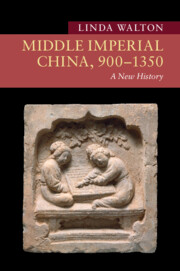Book contents
- Middle Imperial China, 900–1350
- New Approaches to Asian History
- Middle Imperial China, 900–1350
- Copyright page
- Dedication
- Contents
- Figures
- Maps
- Acknowledgments
- Introduction
- 1 The Turbulent Tenth Century
- 2 Song in a Multipolar World
- 3 Schooling, State, and Society in Song and Jin
- 4 An Economic Revolution?
- 5 Cities and Urban Life
- 6 Religious Transformations
- 7 Ways of Knowing
- 8 The Arts of Culture
- 9 Gendered and Generational Lives
- 10 Mapping the Built and Natural Environment
- 11 Sustaining Life and Healing Bodies
- 12 The Mongol Yuan Dynasty in China
- 13 Yuan China in the Mongol Eurasian Empire
- Bibliography
- Index
- New Approaches to Asian History
2 - Song in a Multipolar World
Published online by Cambridge University Press: 20 July 2023
- Middle Imperial China, 900–1350
- New Approaches to Asian History
- Middle Imperial China, 900–1350
- Copyright page
- Dedication
- Contents
- Figures
- Maps
- Acknowledgments
- Introduction
- 1 The Turbulent Tenth Century
- 2 Song in a Multipolar World
- 3 Schooling, State, and Society in Song and Jin
- 4 An Economic Revolution?
- 5 Cities and Urban Life
- 6 Religious Transformations
- 7 Ways of Knowing
- 8 The Arts of Culture
- 9 Gendered and Generational Lives
- 10 Mapping the Built and Natural Environment
- 11 Sustaining Life and Healing Bodies
- 12 The Mongol Yuan Dynasty in China
- 13 Yuan China in the Mongol Eurasian Empire
- Bibliography
- Index
- New Approaches to Asian History
Summary
The eleventh century was a period of intense political conflict and two major reform movements as well as war with the Tangut Xi Xia. Supported by the emperor, Wang Anshi’s mid-eleventh-century program of reforms proposed to increase dramatically the power of the state to intervene in the economy and in society as a whole. Although these reforms were rescinded, and pro- and anti-reform factions took turns in power, Wang’s reform set in motion political debates that would rage for centuries after. A major reorganization of the government designed to rationalize the functions of an increasingly complex bureaucracy took place in the late eleventh century. Encounters with rising steppe empires circumscribed political debates at court throughout the Northern Song. The Khitan Liao Empire was destroyed by one of its own vassal peoples, the Jurchen, who then created their own empire and occupied the northern territory of the Song. This marked the fall of the Northern Song, with its capital at Kaifeng in the north, and the founding of the Southern Song, with the emperor’s “temporary residence” in the Yangzi delta city of Hangzhou. The Jurchen Jin was in turn defeated by the rising Mongols, who then conquered the Southern Song.
Keywords
- Type
- Chapter
- Information
- Middle Imperial China, 900–1350A New History, pp. 38 - 68Publisher: Cambridge University PressPrint publication year: 2023

